Modulation and Wave Propagation | Physics Class 12 - NEET PDF Download
Modulation
The process of superimposing the audio signal over a high frequency carrier wave is called modulation.
In the process of modulation anyone characteristic of carrier wave is varied in accordance with the instantaneous value of audio signal (modulating signal).
Need of Modulation
(i) Energy carried by low frequency audio waves (20 Hz to 20000 Hz) is very small.
(ii) For efficient radiation and reception of signal. the transmitting and receiving antennas should be very high approximately 5000 m.
(iii) The frequency range of audio signal is so small that overlapping of signals create a confusion.
Types of Modulation
(i) Amplitude Modulation In this type of modulation, the amplitude of high frequency carrier wave is varied in accordance to instantaneous amplitude of modulating signal.
Bandwidth required for amplitude modulation= twice the frequency of the modulating signal.
(ii) Frequency Modulation In this type of modulation, the frequency of high frequency carrier wave is varied in accordance to instantaneous frequency of modulating signal
(iii) Pulse Modulation In this type of modulation, the continuous waveforms are sampled at regular intervals. Information is transmitted only at the sampling times
Demodulation
The process of separating of audio signal from modulated signal is called demodulation.
Antenna
An antenna converts electrical energy into electromagnetic waves at transmitting end and pick up transmitted signal at receiving end and converts electromagnetic waves into electrical signal.
Modem
The term modem is contraction of the term modulator and demodulator. Modem is a device which can modulate as well as demodulate the signal. It connect one computer to another through ordinary telephone lines.
Fax (Facsimile Telegraphy)
The electronic reproduction of a document at a distant place is called FAX
Radio Waves
The radio waves are the electromagnetic waves of frequency ranging from 500 kHz to about 1000 MHz. These waves are used In the field of radio communication. With reference to the frequency range and wavelength range, the radio waves have been divided into various categories shown in table.
Frequency Range and Wavelength Range of Radio Waves
S.No. | Frequency band | Frequency range | Wavelength range |
Main Use |
1. | Very-Low Frequency (VLF) | 3 kHz to 30 kHz | 10 km to 100 km | Long distance point to point communication |
2. | Low Frequency (LF) | 30 kHz to 300 kHz | 1 km to 10 km | Marine and navigational purposes |
3. | Medium Frequency (MF) | 300 kHz to 3 MHz | 100 m to 1 km | Marine and broadcasting purposes |
4. | High Frequency (HF) | 3 MHz to 30 MHz | 10 m to 100 m | Communication of all types |
5. | Very-High Frequency (VHF) | 30 MHz to 300 MHz | 1 m to 10 m | T V Radar and air navigation |
6. | Ultra-High Frequency (UHF) | 300 MHz to 3000 MHz | 10 cm to 1 m | Radar and microwave communication |
7. | Super-High-Frequency (SHF) | 3 GHz to 30 GHz | 1 cm to 10 cm | Radar, Radio relays and navigation purposes |
8. | Extremely-High - Frequency (EHF) | 30 GHz to 300 GHz | 1 mm to 1 cm | Optical fibre communication |
Propagation of Radio Waves
The three modes are discussed below.
(i) Ground Wave or Surface Wave Propagation It is suitable for low and medium frequency up to 2 MHz. It is used for local broad casting.
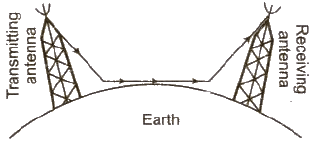
(ii) Sky Wave Propagation It is suitable for radio waves of frequency between 2 MHz to 30 MHz. It is used for long distance radio communication.
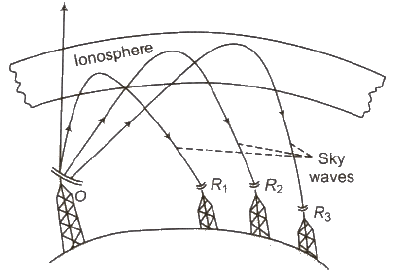
Critical Frequency The highest frequency of radio wave that can be reflected back by the ionosphere is called critical frequency.
Critical frequency, vc = 9 (Nmax)1 / 2
Where, Nmax = number density of electrons/metre3.
Skip Distance The minimum distance from the transmitter at which a sky wave of a frequency but not more than critical frequency, is sent back to the earth.
Skip distance (Dskip) = 2h (Vmax / Vc)2 – 1
where h is height of reflecting layer of atmosphere,
Vmax is maximum frequency of electromagnetic waves and Vc is critical frequency.
Fading The variation in the strength of a signal at receiver due to interference of waves, is called fading.
(iii) Space Wave Propagation It is suitable for 30 MHz to 300 MHz. It is used in television communication and radar communication. It is also called line of sight communication.
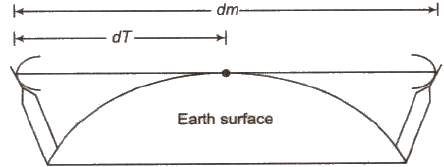
- Range is limited due to curvature of earth. If h be the height of the transmitting antenna, then signal can be received upto a maximum distance
d = √2RH
- If height of transmitting and receiving antennas be hT and hR respectively. The effective range will
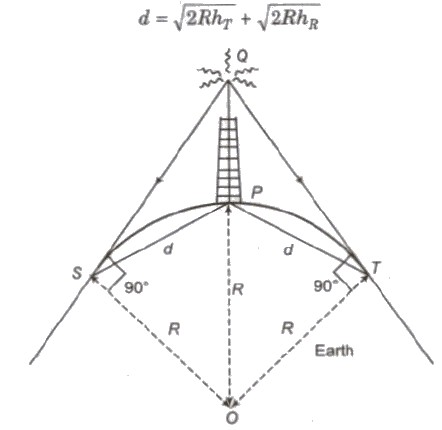
Microwave Propagation
- Microwaves are electromagnetic wave of frequency 1 to 300 GHz, greater than those of TV signals. The wavelength of microwaves is of the order of a few mm.
- Microwave communication is used in radar to locate the flying objects In space.
- These waves can be transmitted as beam signals in a particular direction, much better than radiowave,
- There is no diffraction of microwave around corners of an obstacle which happens to lie along its passage.
Satellite Communication
It IS carried out between a transmitter and a receiver through a satellite. A geostationary satellite is utilized for this purpose, whose time period is 24 hours.
A communication satellite is a space craft, provided with microwave receiver and transmitter. It is placed in an orbit around the earth. The India remote sensing satellites are
IRS-IA, IRS-IB and IRS-IC
The line-of-sight microwave communication through satellite is possible if the communication satellite is always at a fixed location with respect to the earth, e.g., the satellite which is acting as a repeater must be at rest with respect to the earth. It is so far a satellite known as geo-stationary satellite.
The basic requirements for geostationary satellites are as follows:
- The time period of revolution of the satellite around the earth is equal to the time period of rotation of earth about its polar axis i.e., 24 h.
- The sense of revolution of the satellite around the earth is the same as that of the earth about its polar axis i.e., from west to east.
- The orbital plane of revolution of satellite is concentric and coplanar with the equatorial plane of earth.
- The height of geostationary satellite above the equator of earth is nearly 36000 km and its orbital velocity is nearly 3.1 km/s.
The orbit in which the gee-satellite above revolves around the earth is known as geo-synchronous orbit. As its angular speed is synchronized with the angular speed of the earth. therefore, the geo-stationary satellite is also known as geo-synchronous satellite.
Merits of Satellites Communication
- The satellite communication covers wide area for broadcasting a8 compared to other communication systems i.e. it has wide coverage range.
- The satellite communication is also used effectively in mobile communication.
- The satellite communication is found to be much economical as compared to other communication systems on earth. Infact. the cost involved in satellite communication is independent of the distance.
- The satellite communication is most cost effective in remote and hilly areas, such as Ladakh, Himachal Pradesh etc.
- The satellite communication permits transmission of data at rate.
- The satellite communication is very accurate and economical search. rescue and navigation purposes.
Demerits of Satellite Communication
1. If a system on the satellite goes out of order due to environmental stresses, it is almost impossible to repair it.
2. In satellite communication, there is a time delay between transmission and reception, due to extremely large communication path length (greater than 2 x 36000 km). This delay causes a time gap during talking, which proves quite annoying.
Remote Sensing
It is a technique of observing or measuring the characteristics of the object at a distance. A polar satellite is utilized for this purpose.
Distance upto which a signal can be obtained from an antenna is given by
d = √2hR
where, h is height of antenna and R is radius of earth.
LED and Diode Laser in Communication
Light Emitting. Diode (LED) and diode laser are preferred sources for optical communication links to the following features.
- Each produces light of suitable power required in optical communication. Diode laser provides light which is monochromatic and coherent. This light is obtained as a parallel beam. It is used in very long distance transmission.
- LED provides almost monochromatics light. This suitable for small distance transmission. It is infact, a low cost device as compared to diode lasers.
Line Communication
- Transmission lines are used to interconnect points separated from each other. For example interconnection between a transmitter and a receiver or a transmitter and antenna or an antenna and a receiver are achieved through transmission lines.
- Line communication may be in the form of electrical signal or optical signal.
Optical Fibres
An optical fibre is a long thread consisting of a central core of glass or plastic of uniform refractive index. It is surrounded by a cladding of material of refractive index less than that of the core and a protective Jacket of insulating material.
There are three types of optical fibre configuration
- Single mode step index fibre
- Multi mode step index fibre
- Multi mode graded index fibre.
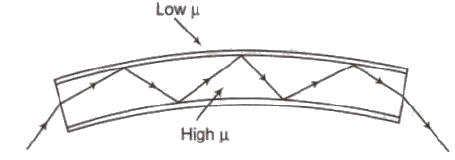
Applications of Optical Fibres
- A bundle of optical fibres is called light pipe. This pipe can transmit as image. Since the pipe is flexible, it can be twisted in any desired manner. Hence it is used medical and optical examination of even the inaccessible parts of human body, e.g., in endoscopy.
- Optical fibres are used in transmission and reception of electrical signals by coverting them first into light signals.
- Optical fibres are used in telephone and other transmitting cables. Each fibre can carry upto 2000 telephone messages without much loss of intensity.
|
97 videos|336 docs|104 tests
|
FAQs on Modulation and Wave Propagation - Physics Class 12 - NEET
| 1. What is modulation and how does it relate to wave propagation? |  |
| 2. What are the different types of modulation techniques? |  |
| 3. How does amplitude modulation (AM) work? |  |
| 4. What is wave propagation and why is it important in wireless communication? |  |
| 5. What are the challenges in wave propagation for wireless communication? |  |

|
Explore Courses for NEET exam
|

|


















